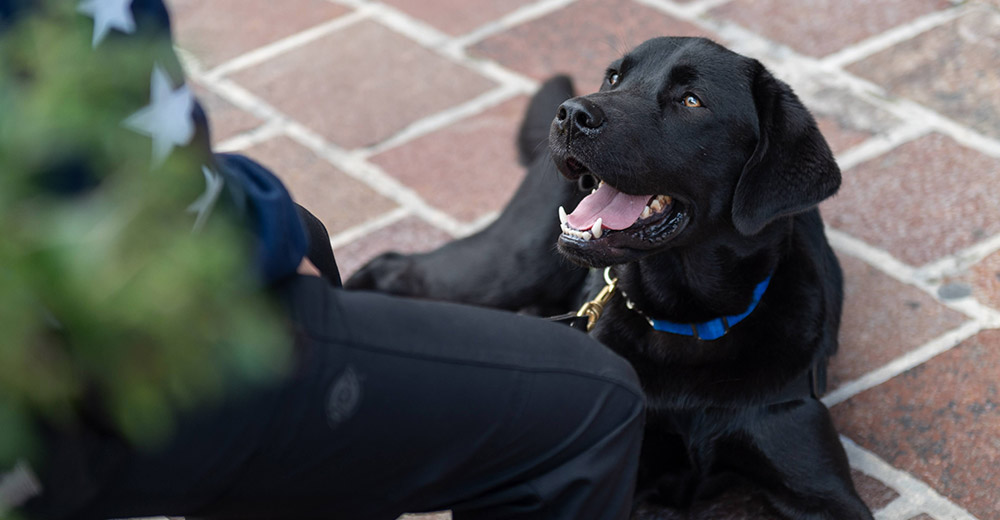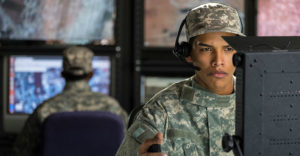Canine Companions, a service dog company, will announce new technology this week that enables trained canines to perform tasks, such as tamping down anxiety and interrupting nightmares, after receiving wireless alerts.
Called CanineAlert, the technology is designed to be integrated with a service dog’s training to mitigate trauma-related nightmares, like those of military veterans suffering from post-traumatic stress disorder (PTSD), according to information provided to TechNewsWorld by Canine Companions.
Beyond just interrupting nightmares, the company noted, the technology speeds up the recovery process, with the service dog initiating tasks to reduce anxiety and hypervigilance while supporting the veteran post-nightmare.
Since receiving their service dogs, veterans have reported improvements in staying asleep, falling back asleep, and overall sleep quality, showcasing the effectiveness of the device in enhancing their sleep patterns and quality of life, the company added.
“Service dogs are specifically trained to assist an individual with a disability,” explained Kerri Rodriguez, an assistant professor in the College of Veterinary Medicine at the University of Arizona.
“Psychiatric service dogs can be trained to assist individuals with a mental health condition such as PTSD or autism,” she told TechNewsWorld. “In the case of PTSD specifically, psychiatric service dogs can be trained to interrupt or alert to an individual’s anxiety, provide calming deep pressure, retrieve medication, or wake up the individual from nightmares.”
“In addition to these trained tasks, we also know that dogs are great at providing nonjudgemental support that can be helpful for those who have experienced trauma,” she added. “For someone with PTSD, a dog’s companionship and comforting presence can also be therapeutic in itself.”
New Independence for Veterans
“We teach our service dogs commands that can help a veteran go out in public and have a life of independence that they did not have prior to receiving a dog,” observed Lindsay Grayson, chief revenue officer at K9s for Warriors, in Ponte Vedra, Fla.
Those commands include “my lap,” where the dog places its paws on the veteran’s legs to relieve anxiety or give the vet a sense of security, and the equivalent of “watch my 6,” where a canine will watch for someone approaching the vet from behind.
Vets with PTSD can be super-vigilant and worried about someone sneaking up behind them, Grayson explained. “The commands give them the sense of security and safety that the dog is watching their back for them and will alert them if someone is approaching,” she told TechNewsWorld.
Grayson noted that the majority of service dogs enlisted by K9s for Warriors are rescue dogs. The dogs must meet certain height, weight, and temperament standards to perform what’s required of them. For example, there’s a “brace” command in which a vet places up to 30% of their weight on the dog to rise from a sitting or kneeling position. “For reasons like that, we go for larger dogs,” she said.
She added that training a dog takes five to eight months, and the success rate with rescue dogs is about 50%. “That’s because we don’t know what a rescue dog has been through before it went to a shelter,” she noted. “Sometimes, they have their own anxieties.”
Quality of Life Improvements
According to Canine Companions’ patent for its technology, a service dog’s handler will wear a device to monitor one or more of their physiological parameters. The monitoring device may include watches, fitness-tracking devices, bands, necklaces, or patches incorporating a processor.
The handler’s monitoring device pairs with a device capable of delivering both a first and a second haptic alert to a service dog trained to interrupt PTSD-related episodes.
The patent explained that while the service animal is trained to monitor its handler for specific actions or behaviors indicative of a PTSD episode, there are times when the service animal may be distracted by the environment — loud noises or crowds, for example — or the handler may not have any outward appearance or characteristics of distress. A dog may also not be aware of a handler’s distress if it’s resting or asleep.
The patent also noted that in addition to being in wireless communication with the dog’s alert device, the data stored in the memory of the handler’s device can be transmitted to a portal for long-term storage and analysis. Stored data can be shared with one or more third parties, such as a physician, counselor, or trainer, who can use it for monitoring, adjustments, and research.
According to Canine Companions, its service dogs have significantly impacted the quality of life of its veteran clients. More than half of them use nightmare interruption and recovery tasks daily or a few times per week. Of those who use the tasks:
- 85% report an improvement in nightmares and night terrors.
- 89% report feeling more comfortable sleeping in a new location.
- 88% report feeling more comfortable sleeping in their own bed.
- 70% report feeling more comfortable sleeping without a protective tool.
- 76% report improvement in falling asleep, staying asleep, and having fewer nightmares since receiving their service dog.
Service Dogs Offer Healing and Hope to Veterans
Rodriguez noted that research suggests service dogs can be beneficial for military veterans with PTSD in several areas.
“Our research has found that compared to veterans on the waitlist to receive a service dog, veterans placed with a service dog have significantly lower PTSD, depression, and anxiety symptoms,” she said.
“Having a service dog is also associated with less social isolation, greater resilience to stress, and better life satisfaction,” she added. “While service dogs are not a cure for PTSD, they have been shown to be associated with overall better well-being compared to usual care alone.”
Grayson pointed out that service dogs can also have medical benefits for vets. “When a veteran enters our program, they can be on anywhere from 14 to 20 medications. Medications for anxiety and not being able to sleep, and that nature,” she explained. “When they get a dog, it relieves the need for those medications.”
“There have been studies where service dogs have contributed to bringing their handler’s cortisol levels to a normal state,” she added. Chronically high cortisol levels are linked to a number of mental health issues, including anxiety, depression, and PTSD.
A service dog can also impact a vet’s mental health. “Studies show that a dog can give a veteran purpose,” Grayson said. When a warrior has suicidal thoughts, they’ll say, ‘I can’t leave my dog. Who will take care of my dog?’ There might be days they don’t want to get out of bed, but they’ll get up to feed and walk the dog.”
“We’ve seen over time that a dog can give a veteran a life of dignity and independence that they had prior to their service,” she said. “They’re not relying on medications, and they’re happy.”


























































